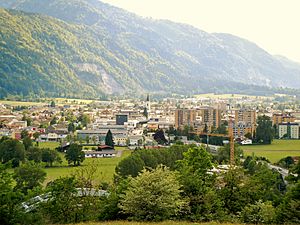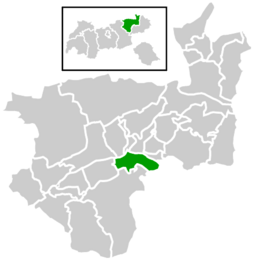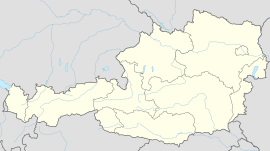Wörgl facts for kids
Quick facts for kids
Wörgl
|
||
|---|---|---|

Wörgl seen from the east (Grattenbergl)
|
||
|
||

Location within Kufstein district
|
||
| Country | Austria | |
| State | Tyrol | |
| District | Kufstein | |
| Area | ||
| • Total | 19.74 km2 (7.62 sq mi) | |
| Elevation | 511 m (1,677 ft) | |
| Time zone | UTC+1 (CET) | |
| • Summer (DST) | UTC+2 (CEST) | |
| Postal code |
6300-6302
|
|
| Area code | 043-5332 | |
| Vehicle registration | KU | |
| Website | www.woergl.at | |
Wörgl (pronounced 'Ver-gul') is a city in Austria. It is located in the state of Tyrol, within the Kufstein area. Wörgl is about 20 kilometers (12 miles) from the border with Bavaria, Germany.
Contents
Population Growth in Wörgl
Wörgl has grown a lot over the years. In 1869, only about 1,080 people lived there. By 2011, the population had grown to over 12,600 people!
| Historical population | ||
|---|---|---|
| Year | Pop. | ±% |
| 1869 | 1,080 | — |
| 1880 | 1,485 | +37.5% |
| 1890 | 2,319 | +56.2% |
| 1900 | 3,126 | +34.8% |
| 1910 | 4,232 | +35.4% |
| 1923 | 4,155 | −1.8% |
| 1934 | 4,196 | +1.0% |
| 1939 | 4,689 | +11.7% |
| 1951 | 6,247 | +33.2% |
| 1961 | 6,828 | +9.3% |
| 1971 | 7,937 | +16.2% |
| 1981 | 8,598 | +8.3% |
| 1991 | 10,041 | +16.8% |
| 2001 | 10,885 | +8.4% |
| 2011 | 12,645 | +16.2% |
Travel and Transportation
Wörgl is an important place for trains. It is a major railway connection point. Trains from Innsbruck and Munich pass through Wörgl. There are also trains that go to Salzburg.
The Wörgl railway station is a main station. It has been called a Hauptbahnhof (which means 'main station' in German) since 2006.
Major roads also go through Wörgl. European route E641 connects Wörgl with Salzburg. The E45 and E60 roads, which are part of Austria's main highways (A12), also pass by Wörgl.
History of Wörgl
World War II Events
Near Wörgl is Itter Castle. This castle was the site of an important battle during World War II. The Battle for Castle Itter happened on May 5, 1945. This was one of the last battles in Europe during the war.
In this battle, soldiers from the surrendered German army (Wehrmacht) fought alongside the United States Army. They were joined by Austrian Resistance fighters and former French political prisoners. They fought against a German SS division. Major Josef Gangl, who led the surrendered German troops, died in this battle. He is buried in Wörgl's cemetery. A street in Wörgl, Sepp Gangl-Straße, is named after him.
The Wörgl Experiment
Wörgl is famous for something called the "Miracle of Wörgl." This happened on July 31, 1932, during the Great Depression. The town started using its own special money. This money was a type of local currency known as Stamp Scrip or Freigeld.
The mayor at the time, Michael Unterguggenberger, used ideas from an economist named Silvio Gesell. This experiment helped Wörgl a lot. More people found jobs. The local government was able to complete projects. They built new houses, a water reservoir, a ski jump, and a bridge. This was very different from other places during the Depression. Also, prices stayed stable, meaning there was no Inflation or deflation.
Many people were interested in this experiment. Even the French Premier Edouard Daladier and economist Irving Fisher came to see it. However, Austria's central bank, the Oesterreichische Nationalbank, stopped the experiment on September 1, 1933.
The famous British economist John Maynard Keynes believed that future economics would learn more from Gesell's ideas than from other thinkers. In 2006, special markers were placed around Wörgl to remember this important event.
Sister Cities
Wörgl has "sister city" relationships with two other towns:
Famous People from Wörgl
Many notable people have connections to Wörgl:
- Reinhard Furrer: A German scientist.
- Gerhard Berger: A former Formula One racing driver. He also used to co-own a racing team called Scuderia Toro Rosso.
- Stefan Horngacher: An Olympic ski jumper.
- Hans Peter Haselsteiner: A building business leader and former politician.
- Richard Kitzbichler: A former player for the Austria national football team. He is now an assistant manager for the Premier League team Southampton F.C..
- Hannes Staudinger: An Austrian cinematographer (someone who works with cameras in movies).
- Gisela Wurm: An Austrian politician.
Images for kids
See also
 In Spanish: Wörgl para niños
In Spanish: Wörgl para niños







